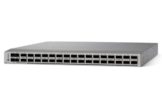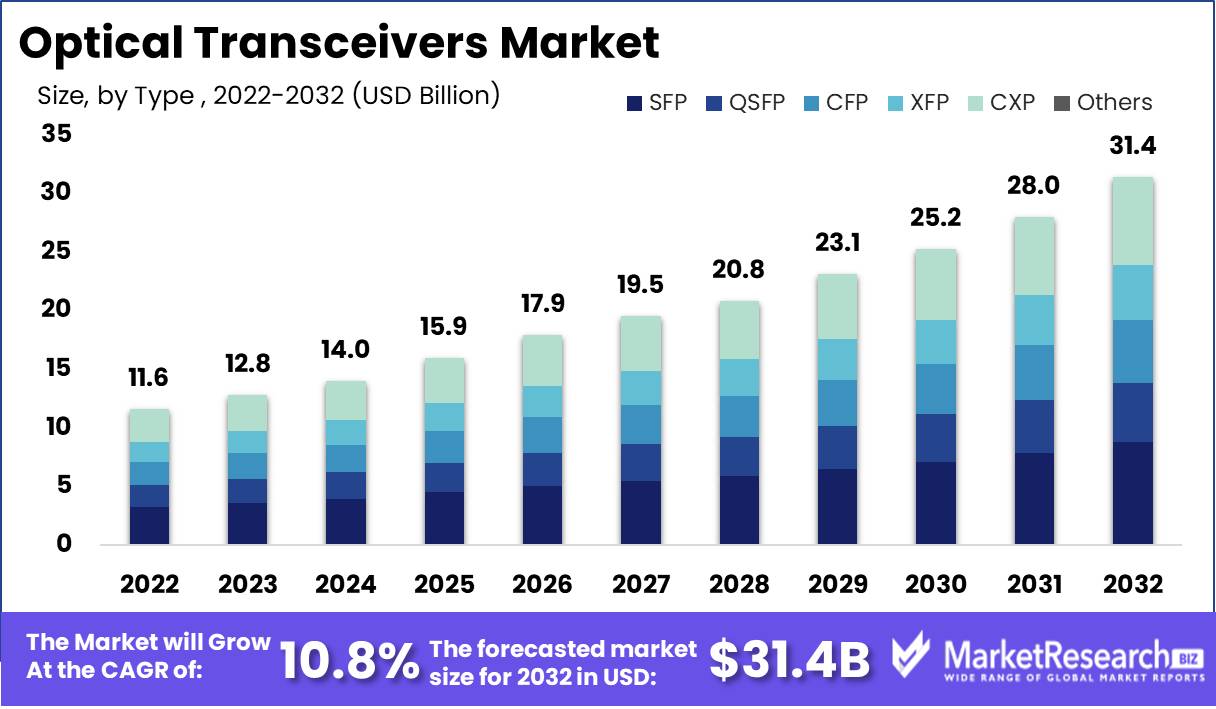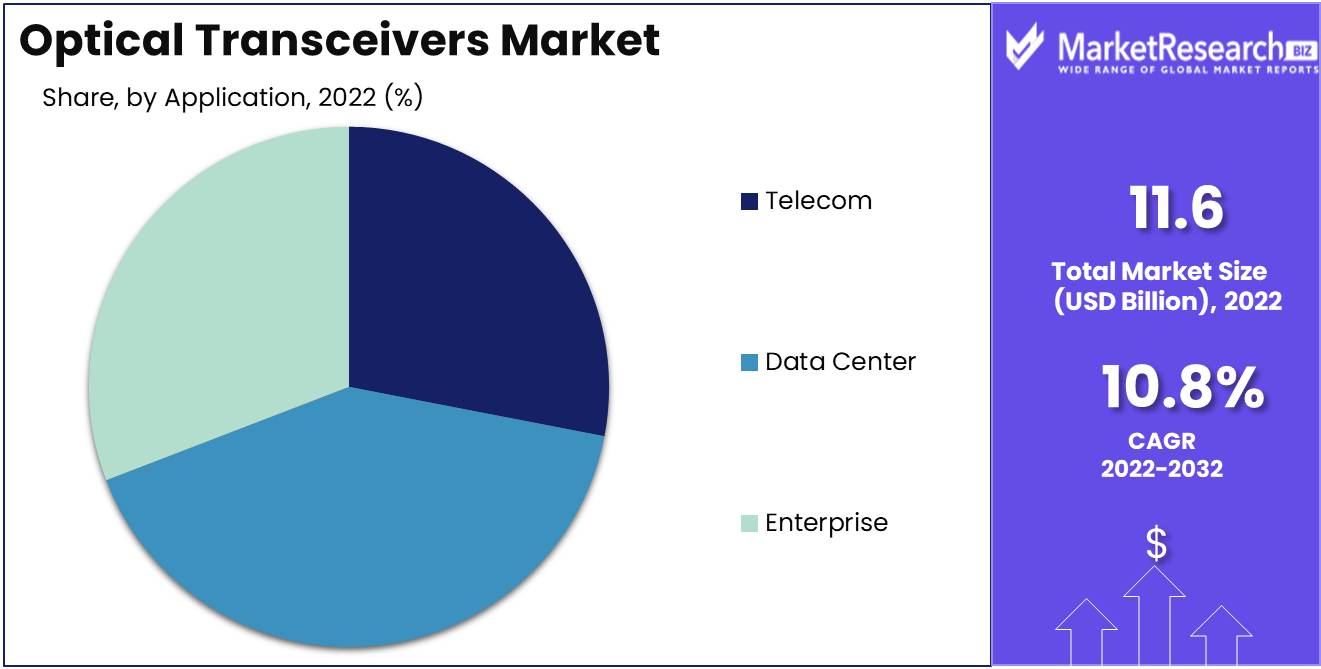
Optical Transceivers Market By Type (SFP, QSFP, CFP, XFP, CXP, Others), By Application (Telecom, Data Center, Enterprise), By Region And Companies - Industry Segment Outlook, Market Assessment, Competition Scenario, Trends, And Forecast 2023-2032
-
3312
-
May 2023
-
161
-
-
This report was compiled by Vishwa Gaul Vishwa is an experienced market research and consulting professional with over 8 years of expertise in the ICT industry, contributing to over 700 reports across telecommunications, software, hardware, and digital solutions. Correspondence Team Lead- ICT Linkedin | Detailed Market research Methodology Our methodology involves a mix of primary research, including interviews with leading mental health experts, and secondary research from reputable medical journals and databases. View Detailed Methodology Page
-
Quick Navigation
Report Overview
Optical Transceivers Market size is expected to be worth around USD 31.4 Bn by 2032 from USD 11.6 Bn in 2022, growing at a CAGR of 10.8% during the forecast period from 2023 to 2032.
Optical Transceivers Market expands with unbridled vitality, attracting the attention of astute observers worldwide. This swiftly expanding industry, propelled by the ingenious application of optical technology, facilitates the transmission of data across vast distances. Explore the labyrinthine complexities of this domain, where industry trends, market dynamics, and emerging opportunities perform a mesmerizing ballet. Optical transceivers, the vanguards of connectivity, link networks by means of optical fiber cables, converting electrical signals to their optical counterparts and vice versa. Their indomitable presence reverberates throughout data centers, enterprise networks, and communication networks, enabling applications for high-speed data communication, switching, and routing.

In the pursuit of improved network performance, optical transceivers stand out for their capacity to transmit and receive data over great distances. Inherently adaptable, these devices support a variety of network architectures and applications. Enjoy the benefits they provide, including high bandwidth, low power consumption, and minimal latency. The rapid expansion of the optical transceivers market is a result of the insatiable demand for high-speed data communication and the pursuit of unmatched network performance. Enthusiasts value the superiority of optical transceivers over conventional copper cables due to their greater bandwidth, faster data transmission rates, and longer lifespan. In addition, their resistance to electromagnetic interference and enhanced security bolster their appeal.
In the midst of this unfolding narrative, innovation assumes center stage as 400G optical transceivers emerge as pioneers, stretching the limits of bandwidth and data transfer rates. Pluggable optical transceivers appear on the scene, providing seamless implementation and simple maintenance, ushering in a new era of convenience.
In this narrative of advancement, ethical concerns cast a shadow. Use of conflict minerals raises legitimate concerns. However, virtuous businesses champion responsible procurement and production, enshrining transparency, explicability, and accountability in their supply chains.
Driving factors
Demand for High-Speed Data Communication Is Growing
Optical Transceivers Market is projected to expand steadily over the next few years, fuelled by a number of favorable trends. Increasing demand for high-speed data communication is one of the primary motivating factors. As businesses and consumers demand quicker and more reliable communication, the demand for optical transceivers able to facilitate high-speed data transfer increases.
Increased Adoption of Cloud Services
The pervasive adoption of cloud services is another trend positively influencing the optical transceivers market. There is a need for sophisticated network infrastructure that can effectively support cloud servers and applications, as more businesses and individuals rely on them. Optical transceivers play a vital role in facilitating the efficient and seamless transfer of data within cloud environments.
Increasing prevalence of Internet of Things (IoT) devices
Increasing demand for Internet of Things (IoT) devices drives the optical transceivers market forward. Optical transceivers are becoming crucial for establishing and maintaining robust IoT networks as the number of internet-connected devices increases and data transfer demands increase.
Fiber-Optic Networks and High-Definition Video Services are in high demand.
Increasing demand for fiber-optic networks and high-definition video services drives growth in the optical transceivers market. Optical transceivers play a key role in facilitating the efficient transmission of data over fiber-optic cables as the demand for quicker data transfer and improved visual quality grows. In addition, developments in optical transceiver technology are expanding the devices' applications and use cases.
The implementation of 5G networks, data centers, and server farms.
The increasing adoption of 5G networks and the expansion of data centers and server farms are major contributors to the market expansion of optical transceivers. Optical transceivers play a crucial role in meeting these requirements because they allow for high-speed, dependable data communication. In addition, the healthcare and defense industries rely on optical transceivers for applications such as medical imaging and secure communications.
Changes in Regulations and Emerging Technologies
Regulatory changes, such as the adoption of new standards such as ROHS, could affect the design and production of optical transceivers. In addition, emerging technologies such as silicon photonics and free-space optics have the potential to completely transform the market. In addition, the prospect of new market entrants or disruptive technologies presents obstacles for established participants in Optical Transceivers Market.
Restraining Factors
The Exorbitant Expenses Involved with Optical Transceivers
The high cost of optical transceivers can be attributed to the high precision components, cutting-edge technology, and complex manufacturing procedures that are required to produce them. This prevents many businesses, particularly those that are very small or medium-sized and have limited budgets, from adopting them.
Alternative Technologies That Are Currently Available
Copper-based cables are an option that can save expenses when compared to optical transceivers. Optical Transceivers Market is expected to decrease as a result of the availability of cheaper alternatives that offer equivalent data transmission speeds.
Installation and maintenance that are difficult to perform
Because the process of installing and maintaining optical transceivers involves specialist technical expertise, it can be difficult for smaller businesses to incorporate them into their operations. Further discouraging potential purchasers from adopting optical transceivers are the costs that are connected with doing so.
Optical Transceivers Have a Restricted Operating Range
Optical transceivers have a restricted range for the data that they can transmit, which makes communication across large distances challenging. The range is determined by the kind of fiber and the quality of the transceiver, neither of which are guaranteed to fulfill the requirements of clients looking for high-speed, long-distance transmission.
There are certain concerns regarding the safety of fiber-optic networks
Even while fiber-optic networks provide a higher level of protection than copper-based networks, it is still possible for these networks to have their security compromised. Concerns have been raised among prospective customers due to the fact that encryption and authentication mechanisms can be broken. Because of the apparent advantages to their security, some businesses may choose to use copper-based connections.
By Type Analysis
Over the years, the demand for optical transceivers in the telecommunications industry has increased dramatically, and the SFP segment now dominates the market. The SFP (Small Form-Factor Pluggable) transceiver is a small, pluggable device that allows data transmission between optical and electrical networks. Its compact dimension makes it an excellent option for data center applications requiring high-density configurations. The increased demand for high-speed data transmission in these nations has necessitated cost-effective and high-performance solutions, which the SFP segment provides.
SFP transceivers are in greater demand as a result of the growth of cloud computing and big data. Consumers seek solutions that are fast, dependable, and capable of managing immense quantities of data. In addition to providing these features, the SFP segment is also simple to implement and maintain. Increasing demand for high-speed data transmission and demand for cost-effective solutions will drive the SFP segment of the optical transceiver market. In addition, the use of SFP transceivers in data center applications will continue to rise, propelling the expansion of this market segment.
By Application Analysis
Due to the increasing demand for high-bandwidth solutions to support large quantities of data in the telecommunications industry, the Data Center segment dominates the optical transceiver market. In data center applications, optical transceivers are integral components, and the demand for high-performance solutions will continue to drive the expansion of this market segment. The demand for high-speed data transmission in data center applications is driving consumers to seek out high-performance solutions. The demand for optical transceivers, which are essential components of data center infrastructure, will continue to rise.
The growing demand for high-bandwidth solutions to support large quantities of data in data center applications will contribute to the expansion of the Data Center segment of the optical transceiver market. Combined with the rise of cloud computing and big data, the expansion of the telecommunications industry will further propel the expansion of this market segment.

Key Market Segments
By Type
- SFP
- QSFP
- CFP
- XFP
- CXP
- Others
By Application
- Telecom
- Data Center
- Enterprise
Growth Opportunity
Demand for faster Internet and broadband services is growing
In today's digital society, the demand for high-speed internet and broadband services is rapidly increasing. As more people connect to the internet, the demand for quicker and more reliable connections grows. This has increased the demand for optical transceivers with greater bandwidths and quicker data transfer rates.
The expanding use of virtualization and cloud computing technologies
The technologies of virtualization and cloud computing have become indispensable for businesses seeking to increase their productivity and efficiency. These technologies necessitate high-performance networking solutions capable of delivering rapid and dependable data transfer rates over great distances. Optical transceivers provide the necessary bandwidth and speed for cloud computing and virtualization, making them the optimal choice for these applications.
Aerospace and Defense Industries Display a Rising Demand for Optical Transceivers
For their critical applications, the aerospace and defense industries require robust and dependable networking solutions. Due to their durability, high-bandwidth capabilities, and ability to operate in adverse environments, optical transceivers are becoming increasingly popular in these industries. As the demand for optical transceivers in these industries continues to rise, we anticipate the Optical Transceivers Market will experience substantial growth.
Technological Developments in Silicon Photonics
In recent years, significant advances in silicon photonics technology have enabled the development of compact and quick optical transceivers. These developments have resulted in the creation of smaller, more efficient, and more cost-effective optical transceivers, making them more accessible for a broader spectrum of applications.
Increasing expenditures on research and development
Enhancing the capabilities of optical transceivers through research and development also contributes to the expansion of the Optical Transceivers Market. Companies are investing significantly in R&D to create new and more advanced optical transceivers with quicker data transfer rates, larger bandwidths, and enhanced performance.
Latest Trends
Emerging Trends and Major Market Shifts
Optical transceivers facilitate optical signal transmission and reception over fiber optic networks. They are extensively utilized in numerous industry verticals, including telecommunication, healthcare, and data center. In recent years, the global market for optical transceivers has expanded rapidly due to the increasing demand for high-speed optical networks. The dominant market trends that will shape the future of the optical transceivers industry.
Increasing 400G Optical Transceiver Adoption
Adoption of quicker data transmission rates has increased the demand for network solutions with greater bandwidth, resulting in a growing demand for 400G optical transceivers. These transceivers are capable of transmitting 400 gigabits per second (Gbps) of data over single-mode fiber, making them ideal for data centers and telecom networks. The rise of cloud-based applications, such as big data analytics, artificial intelligence, and internet of things applications, has also increased the adoption of 400G optical transceivers. As the demand for quicker and more efficient data transfer continues to rise, we can anticipate increased investment in the development of 400G optical transceivers over the next few years.
Demand for Optical Transceivers in the Healthcare Industry Is Growing
For optical transceivers, the healthcare industry is a key application area. In numerous medical applications, such as patient monitoring, diagnostic imaging, and surgical apparatus, optical transceivers are extensively employed. In the healthcare industry, the demand for advanced medical technologies such as telemedicine and digital health has fueled the growth of the optical transceivers market. Optical transceivers are an ideal solution for healthcare applications because of their ability to transmit significant quantities of data in real time. As the demand for advanced medical technologies continues to rise, optical transceivers will likely be in greater demand in the healthcare industry.
Increasing 5G Network Adoption
5G technology is expected to bring about significant shifts in the telecommunications industry. 5G networks could provide quicker data transfer speeds, reduced latency, and increased network capacity. As a result, it is anticipated that the demand for optical transceivers that facilitate 5G networks will increase. 5G requires fiber optic networks to support the network's high bandwidth requirements. This has increased the demand for optical transceivers in the telecom and data center markets. We anticipate a rise in demand for optical transceivers that support 5G technology as the deployment of 5G networks is anticipated to continue over the next few years.
Increasing Demand for Optical Transceivers Based on Silicon Photonics
Due to their high-speed data transmission capabilities and minimal power consumption, silicon photonics-based optical transceivers are acquiring popularity. The integration of silicon photonics with optical transceivers has made it possible to produce transceivers that are both compact and efficient. Data centers, high-performance computing, and defense are just a few of the many applications for optical transceivers based on silicon photonics. As the demand for high-speed data transmission with minimal power consumption continues to rise, silicon photonics-based optical transceivers will likely become more popular.
Demand for Pluggable Optical Transceivers is Growing
Pluggable optical transceivers are gaining popularity due to their adaptability and usability. They are utilized in a variety of applications, including data centers and enterprise networks. Utilizing pluggable optical transceivers facilitates network enhancements and maintenance. Pluggable optical transceivers have become more prevalent in data centers due to the increasing demand for high-speed data transfer. As Optical Transceivers Market continues to expand, we anticipate an increase in demand for pluggable optical transceivers.
Regional Analysis
North America holds a sizeable portion of the expanding industry. In recent years, there has been an increase in the demand for high-speed data communication, as businesses and individuals require rapid and reliable connectivity to support their digital requirements. Consequently, Optical Transceivers Market has experienced significant growth, with North America playing a pivotal role in this industry. This article will examine the reasons for North America's dominance in the optical transceivers market, with a particular emphasis on the United States as the region's greatest market contributor.
Increasing demand for cloud services is one of the primary reasons North America is anticipated to hold a significant share of the optical transceivers market. As it enables more efficient and scalable operations, cloud computing has become a crucial component of modern enterprises. This has led to a surge in demand for optical transceivers, which provide high-speed data communication. In addition to cloud-based services, the expanding use of 5G technology also contributes to the demand for optical transceivers. 5G networks necessitate high-speed data transmission, making optical transceivers an integral part of this technology.
A further factor contributing to North America's market dominance in optical transceivers is the presence of market leaders in the region. North American corporations such as Intel Corporation, Broadcom Inc., and Finisar Corporation hold a substantial market share. The United States is anticipated to be the largest contributor to the optical transceivers market in North America. Its sophisticated IT infrastructure and strong presence of major market participants have elevated it to a leading position in the industry.

Key Regions and Countries
North America
- US
- Canada
- Mexico
Western Europe
- Germany
- France
- The UK
- Spain
- Italy
- Portugal
- Ireland
- Austria
- Switzerland
- Benelux
- Nordic
- Rest of Western Europe
Eastern Europe
- Russia
- Poland
- The Czech Republic
- Greece
- Rest of Eastern Europe
APAC
- China
- Japan
- South Korea
- India
- Australia & New Zealand
- Indonesia
- Malaysia
- Philippines
- Singapore
- Thailand
- Vietnam
- Rest of APAC
Latin America
- Brazil
- Colombia
- Chile
- Argentina
- Costa Rica
- Rest of Latin America
Middle East & Africa
- Algeria
- Egypt
- Israel
- Kuwait
- Nigeria
- Saudi Arabia
- South Africa
- Turkey
- United Arab Emirates
- Rest of MEA
Key Players Analysis
Cisco Systems Inc., a multinational powerhouse in the technology industry, dominates the optical transceivers market with its extensive range of meticulously crafted products. These optical transceivers cater to diverse applications in data center networks, service provider networks, and enterprise networks, pushing the boundaries of what is possible.
Finisar Corporation, a global leader in optical transceiver technology, continuously strengthens its position in the market. With a wide array of optical transceivers designed for various applications, Finisar Corporation embraces cutting-edge innovation, leading to the birth of revolutionary products.
Huawei Technologies Co., Ltd., a prominent technological giant, stands out with its impressive portfolio of optical transceivers covering 10G, 25G, and 100G applications. Driven by a thirst for advancement, Huawei Technologies engages in relentless research and development, consistently introducing innovative products and securing its esteemed position in the market.
Lumentum Holdings Inc. commands attention in the optical transceivers market, casting a shadow over its competitors. Its vast repertoire encompasses telecom, enterprise, and data center applications, showcasing its boundless ingenuity. Renowned for impeccable craftsmanship and unwavering commitment to excellence, Lumentum Holdings offers high-quality products and revolutionary solutions that defy conventions.
Broadcom Inc., a shining star in the technological landscape, leaves an indelible mark on the world of innovation. As a global leader, Broadcom weaves a seamless web of optical transceivers tailored for a wide range of applications. With a relentless pursuit of progress, Broadcom continually crafts innovative products and pioneers groundbreaking technologies, solidifying its unwavering market standing.
Top Key Players in Optical Transceivers Market
- Finisar Corporation
- Accelink Technologies Co., Ltd.
- Lumentum Holdings Inc.
- Oclaro, Inc.
- Foxconn Electronics Inc.
- Source Photonics, Inc.
- NeoPhotonics Corporation
- Reflex Photonics Inc.
- Oplink Communications, Inc.
- Huawei Technologies Co. Ltd.
Recent Development
In July 2021, The Optical Transceivers Market witnessed a number of new developments. Infinera Corporation has announced the availability of its 800G per wavelength optical transceivers, promising to support next-generation applications with high-speed, low-latency connectivity.
In March 2021, Intel Corporation debuted its new spectrum of silicon photonics-based optical transceivers establishing a new benchmark for optical networking performance and energy efficiency. The most recent offering from the company supports greater distances and bandwidth, delivering superior connectivity to data centers and cloud networks.
In February 2021, Cisco Systems Inc. announced the launch of its new range of 400G optical transceivers, designed to facilitate quicker and more reliable communication between data center servers, switches, and routers. The latest offering from the company provides increased bandwidth, enhanced performance, and reduced power consumption.
In November 2020, Broadcom Inc. made headlines with the release of its new range of 200G optical transceivers, which were designed to meet the expanding demand for higher performance and reduced latency among data center operators. The most recent offering from the company supports the most advanced protocols and applications and provides exceptional performance and adaptability.
In October of 2020, NeoPhotonics Corporation announced the release of its new line of 400G QSFP-DD and OSFP optical transceivers, a comprehensive solution for next-generation networks. The latest offering from the company provides low-power, high-speed connectivity to data centers, cloud networks, and other applications.
Report Scope:
Report Features Description Market Value (2022) USD 11.6 Bn Forecast Revenue (2032) USD 31.4 Bn CAGR (2023-2032) 10.8% Base Year for Estimation 2022 Historic Period 2016-2022 Forecast Period 2023-2032 Report Coverage Revenue Forecast, Market Dynamics, COVID-19 Impact, Competitive Landscape, Recent Developments Segments Covered By Type: SFP, QSFP, CFP, XFP, CXP, Others
By Application: Telecom, Data Center, EnterpriseRegional Analysis North America – The US, Canada, & Mexico; Western Europe – Germany, France, The UK, Spain, Italy, Portugal, Ireland, Austria, Switzerland, Benelux, Nordic, & Rest of Western Europe; Eastern Europe – Russia, Poland, The Czech Republic, Greece, & Rest of Eastern Europe; APAC – China, Japan, South Korea, India, Australia & New Zealand, Indonesia, Malaysia, Philippines, Singapore, Thailand, Vietnam, & Rest of APAC; Latin America – Brazil, Colombia, Chile, Argentina, Costa Rica, & Rest of Latin America; Middle East & Africa – Algeria, Egypt, Israel, Kuwait, Nigeria, Saudi Arabia, South Africa, Turkey, United Arab Emirates, & Rest of MEA Competitive Landscape Finisar Corporation, Accelink Technologies Co., Ltd., Lumentum Holdings Inc., Oclaro, Inc., Foxconn Electronics Inc., Source Photonics, Inc., NeoPhotonics Corporation, Reflex Photonics Inc., Oplink Communications, Inc., Huawei Technologies Co. Ltd. Customization Scope Customization for segments, region/country-level will be provided. Moreover, additional customization can be done based on the requirements. Purchase Options We have three licenses to opt for: Single User License, Multi-User License (Up to 5 Users), Corporate Use License (Unlimited User and Printable PDF) -
-
- Finisar Corporation
- Accelink Technologies Co., Ltd.
- Lumentum Holdings Inc.
- Oclaro, Inc.
- Foxconn Electronics Inc.
- Source Photonics, Inc.
- NeoPhotonics Corporation
- Reflex Photonics Inc.
- Oplink Communications, Inc.
- Huawei Technologies Co. Ltd.




